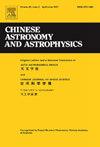Classification of Galaxy Morphology Based on FPN-ViT Model
Q4 Physics and Astronomy
引用次数: 0
Abstract
With the development of artificial intelligence technology, the research of galaxy morphology classification using deep learning methods has made great progress, but there are still shortcomings in classification accuracy, automation, and spatial characteristics representation of galaxies. The Vision Transformer model (ViT) has good robustness in galaxy morphology classification, but has limitations in handling multi-scale images. In this paper, we propose to introduce the Feature Pyramid Networks (FPN) into the ViT model to classify galaxies. The results show that the average accuracy, precision, recall, and F1-score of the FPN-ViT model are above 95%, and the indexes are improved compared with the traditional ViT model. Meanwhile, we add different levels of Gaussian noise and pretzel noise to the original galaxy images to verify that the FPN-ViT model can obtain better classification performance for low signal-to-noise ratio data. In addition, to evaluate the model comprehensively, the t-distributed Stochastic Neighbor Embedding (t-SNE) algorithm is used to visualize and analyze the classification results, which can show the effect of FPN-ViT model on galaxy morphology classification more directly. The application of FPN network to the classification of galaxy morphology by ViT model is a new attempt, which is of great importance for the subsequent research.
基于FPN-ViT模型的星系形态分类
随着人工智能技术的发展,利用深度学习方法进行星系形态分类的研究取得了很大进展,但在分类精度、自动化程度、星系空间特征表征等方面仍存在不足。视觉变换模型(Vision Transformer model, ViT)在星系形态分类中具有较好的鲁棒性,但在处理多尺度图像时存在局限性。本文提出在ViT模型中引入特征金字塔网络(FPN)来对星系进行分类。结果表明,FPN-ViT模型的平均正确率、精密度、查全率和f1得分均在95%以上,与传统的ViT模型相比均有提高。同时,我们在原始星系图像中加入了不同程度的高斯噪声和椒盐椒盐噪声,验证了FPN-ViT模型对于低信噪比数据能够获得更好的分类性能。此外,为了对模型进行综合评价,采用t分布随机邻居嵌入(t-SNE)算法对分类结果进行可视化分析,可以更直接地显示FPN-ViT模型对星系形态分类的效果。将FPN网络应用于ViT模型对星系形态进行分类是一种新的尝试,对后续的研究具有重要意义。
本文章由计算机程序翻译,如有差异,请以英文原文为准。
求助全文
约1分钟内获得全文
求助全文
来源期刊

Chinese Astronomy and Astrophysics
Physics and Astronomy-Astronomy and Astrophysics
CiteScore
0.70
自引率
0.00%
发文量
20
期刊介绍:
The vigorous growth of astronomical and astrophysical science in China led to an increase in papers on astrophysics which Acta Astronomica Sinica could no longer absorb. Translations of papers from two new journals the Chinese Journal of Space Science and Acta Astrophysica Sinica are added to the translation of Acta Astronomica Sinica to form the new journal Chinese Astronomy and Astrophysics. Chinese Astronomy and Astrophysics brings English translations of notable articles to astronomers and astrophysicists outside China.
 求助内容:
求助内容: 应助结果提醒方式:
应助结果提醒方式:


